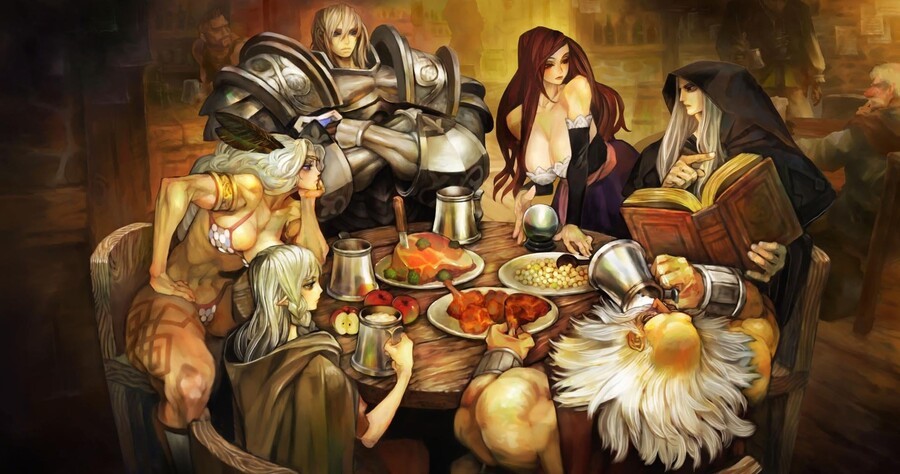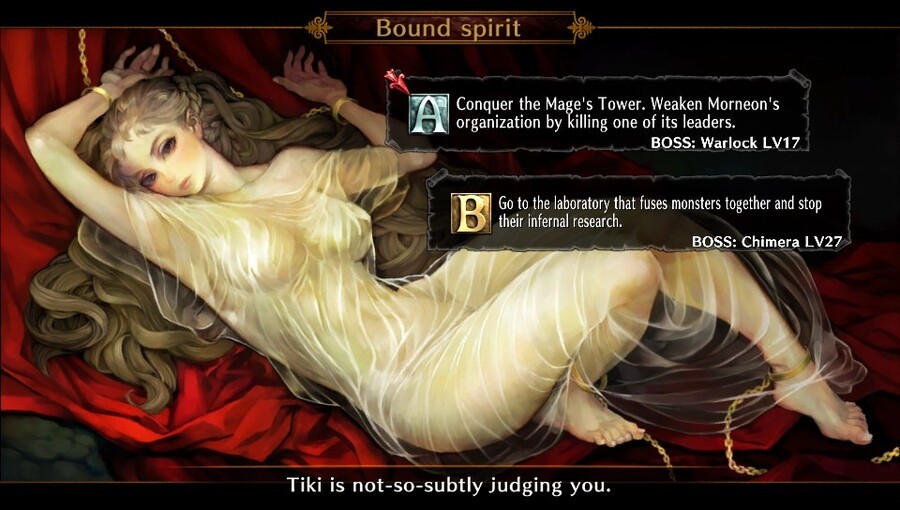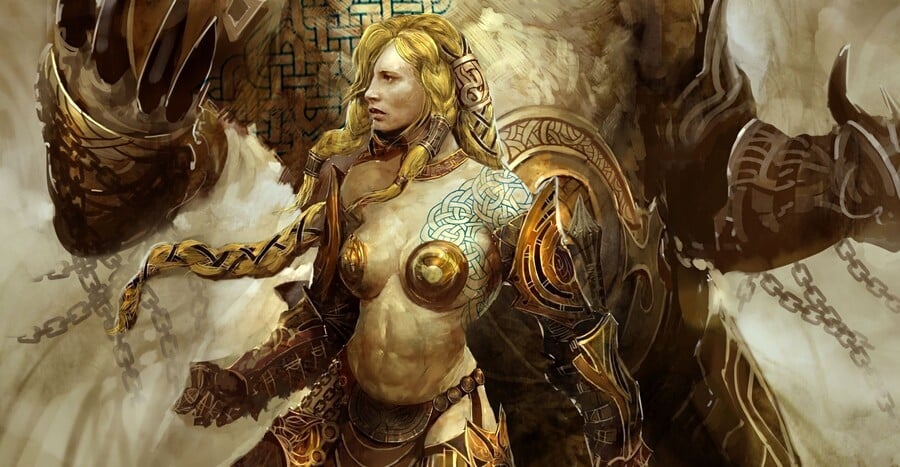
Given the recent furore over the lack of female playable characters in Assassin's Creed: Unity — and the fact that the previously controversial action RPG Dragon's Crown is currently part of Europe's PlayStation Plus Instant Game Collection — I've been having plenty of time to think about how sexism manifests itself in the video game industry, and perhaps more importantly, how the gaming press reacts when it spots something it finds objectionable. Unsurprisingly for a hobby which is dominated by teenage males, women are often treated as objects of lust rather than living, breathing people; an irksome issue which is by no means exclusive to video games, and can be found in practically every other type of media — music and movies especially.
Firstly, let me state that I'm a massive, massive fan of the work of Vanillaware and its founder, George Kamitani. From the moment I saw screenshots of Princess Crown on the Sega Saturn in a copy of GameFan magazine back in the late '90s, I fell in love with the 2D art style which would become the studio's trademark. Odin Sphere, GrimGrimoire and Muramasa: The Demon Blade all followed, and when Dragon's Crown was announced, it quickly became my most wanted release. Then the storm hit; critics started to point out — quite rightly, too — how ridiculous the female playable characters looked, with their massive, heaving bosoms and impossibly proportioned behinds.

While Kamitani has never shied away from such overly-sexulaised portrayals of women in the past (even the impossibly cute Princess Crown turned its wide-eyed protagonist into an S&M freak towards the end of the adventure), Dragon's Crown takes things to an entirely new level of absurdity. The two playable female characters — the Sorceress and Amazon — boast physiques which would make Jessica Rabbit blush; the former has a pair of breasts which look like they could tear free of her chest at any moment, while the latter is blessed with trunk-like thighs and a derrière so massive it presumably requires her to book two seats instead of one whenever she takes a horse-drawn carriage ride through the leafy suburbs of Hydeland.
Quite rightly, many of the reviews which appeared when the game was first released gave a significant amount of attention to the character design, with many pointing out that the impossibly burly appearance of the some of the male characters was equally disturbing. While the majority of reviewers could agree that the game had merit (we gave both the PS3 and Vita editions 8/10 scores), there was little doubt that the questionable visuals had tempered the appeal somewhat.

I played the game briefly when it was first released and for some reason or another wasn't able to give it the attention it deserved — ironic when you consider how excited I was pre-launch. It's highly likely that subconsciously, the drama surrounding the game's art style had put a dampener on my enthusiasm, but when Dragon's Crown became part of Europe's PlayStation Plus collection and I heard others talking about it, I decided it was time for me to give it a second chance and fully devote myself to the title. Not only have I massively enjoyed my time with Vanillaware's latest epic, but I was surprised to find that I wasn't totally and utterly repulsed by the visuals, as some of my fellow critics had been.
In fact, what struck me was the fact that so few of the game's attackers had even bothered to point out that Dragon's Crown has its tongue so firmly planted in its cheek that it's practically bursting through the skin. Unlike western fantasy role-playing games — which typically showcase sexualised, scantily-clad females without a single trace of irony — Dragon's Crown is clearly poking fun at the tropes which litter the genre. The male fighter character has a massive upper body but scrawny, child-like legs, while the dwarf is short on stature but has more muscle mass than Arnold Schwarzenegger and Sylvester Stallone combined. It's clear that Kamitani and his team are having fun here, rather than seriously presenting what they think a game of this type should look like.

Indeed, in his response to Kotaku's Jason Schreler, Kamitani made it clear that the graphics shouldn't be taken too seriously:
I decided to exaggerate all of my character designs in a cartoonish fashion.
I exaggerated the silhouettes of all the masculine features in the male characters, the feminine features in female characters, and the monster-like features in the monsters from many different angles until each had a unique feel to them. I apologize to those who were made uncomfortable by the art’s appearance, and did not see the same light-hearted fantasy in my designs.
It seems almost churlish to point this out, as this is a game which also features a homage to the killer rabbit scene in Monty Python's Holy Grail and parodies Disney's Fantasia by having a magical mouse appealing to you for assistance when a spell goes wrong. Unlike western RPGs — such as Diablo, Elder Scrolls and The Witcher 2 (the latter of which has a sex scene which is almost entirely focused on the Triss Merigold's naked body — a character who would later star as a virtual Playboy model) — Dragon's Crown doesn't even begin to take itself seriously.

However, this alone doesn't excuse the fact that even through the mirth, women are still being treated predominantly as sexual objects in Vanillaware's title. The infamous interactive cutscenes — one of which sees you touching a shackled, barely-clothed woman as she moans and twists — can hardly be described as parody, even when the game informs you that your ever-present fairy companion is "judging you" as you gleefully prod away with your digit. It's at these points that it becomes harder to defend Kamitani claims that the game is deliberately over the top, and to be honest Dragon's Crown would have been better off had they not been included — they serve no other purpose than to titillate male players.
Even so, it still strikes me as strange that many reviews didn't pick up on the degree of humour which exists in Dragon's Crown. Much of the dialogue is very funny indeed — even more so if you're familiar with the kind of nonsense which often gets spouted in RPG titles — and the distinctly "western" feel that the game has lends credence to the view that it is very much a pastiche of North American and European role-players, seen through the eyes of a Japanese studio which has poked fun at the genre's obsession with muscle-bound warriors and female characters who dash into battle wearing little more than underwear. Dragon's Crown may have overstepped the mark when it comes to wantonly objectifying women, but the western critics who came down so strongly on it should perhaps direct some of their venom closer to home, primarily at those western titles which make the same mistake but make no effort to add a humourous slant.



Comments 19
Good read, Damien, and I totally agree. After playing it for about 50 hours, it's become painfully obvious (at least to me) that it's largely a parody on Western RPG and table top game design. It really is very comical when you get down to it.
Not so much centered around Dragon's Crown but generally about the depiction of females in games, I think that one has to makes a difference in what's really sexist and what's just exaggerated. Especially the japanese market has fitting examples for both.
Let me explain.
For example, Mario, with the seemingly incapable princess Peach (she ALWAYS gets captured she should know already) to me is more sexist (I don't take offense by it though, it's still a kid's game - which doesn't make the matter better if you think about it) than a game like for example MGS:5 where the Sniper "Quiet" was in the press for her outfit. Why?
Peach is a stereotype female that's not able to save her own arse, she needs the masculine (mustache!!) and manly (fat ass and belly) plumber to save her. Thats sexist.
Quiet on the other hand, while it's debatable if she NEEDS to wear so little clothes, is a strong character that fights for her own and is just an EXAGGERATED female (all female attributes turned to 10) no more or less as Snake is an exaggerated male. Is he sexist? Most people don't even care or don't get it, but Snake is not more sexistified than Quiet is. Beauty, round body shapes and being a gracile and gentle appearance ARE female traits that might be exaggerated as much as muscles, a rough voice and a stern mind are male attributes that might be exaggerated for the depiction of a character. In my book thats not sexist.
Sexist is depicting men as ALWAYS the bad guys. The alcoholics, rough assh*les enjoying what they do. That's a sexist depiction of a male. It's all very context senstive of course. Imagine a female video game character being all lush and sexy and playing with her physical traits, you could easily say it's a sexist depiction of a woman, but what - in the game world - it's the characters CHOICE to act that way, just like a real woman has all the rights in the world to enjoy and show her body, is it sexist then? I don't think so, if the context is right, a sparsely dressed woman with huge boobs can even be more FEMINIST than anything else.
Share your thoughts.
As Silly Westerners, our concepts of beauty/shame/privacy/etc. override what else the game offers. Lots of cultures don't employ the concept of "personal space" that we're all used to receiving (Idk if you'd be able to play/watch anything on a Japanese train without folks next to you watching). We all just have to be wary of any ethnocentrism when it comes to creepy video games. As a democrat, though, the sexism argument, to me, falls flat because of course men and women were never treated equally by any culture, and still aren't. Humanity is still "sexist" today due to our understanding of bio/psychology, and not only toward women. I think the game is trying to show how easily some exaggeration of mere physical features can change our interpretation of other unrelated aspects.
The thing is, as you pointed out. It still objectifys You can try to parody, but you still objectify. They can try justify all they want, but they make something which they still enjoy from a sexual standpoint, which throws away all the parody justification. There is also a point of just where you're laughing at something, but still objectifying all the same, just with sense img humor.
@Damo there are three playable female characters.
Good read I was never really sucked into the controversy as pretty much all the characters have really exaggerated styles (that I found comical) and the game underneath is a lot of fun which is all I look for.
I haven't played this yet, but after checking out this article I feel inclined to get a Vita again so I can.
Great article. I think it's very well written and you do have a point.
I've been playing Dragon's Crown the last 5 days and I have to mostly agree with all your points. Yes, it is comedy and the game is absolutely great, so getting a lower score for its art is quite silly to me, as it's clearly not meant to be taken seriously.
Having said that, I also agree with the point you make in the penultimate paragraph. I've seen many movies and tv shows where they show boobs as a parody but at the end of the day, it's still boobs that do in fact attract an audience. Just because some of you might find them way too big to be attractive, it doesn't mean everyone feels this way or that whoever makes this decision to include them as a prominent feauture is not aware that there is an audience for that. As a matter of fact, check almost any anime. Anime like Fairy tail. There are many main characters with just as big boobs as the sorceress'.
If you make a game full of gore and say "but it's parody", it doesn't make it any less gore. As for The amazon's thighs, I've read quite a few positive comments around the web and people saying they'd buy the game for that reason alone.
The game is still great and that's all that matters as far as I'm concerned.
Now I am not sexist, but who cares if they objectify women? Developers are people too and they can do whatever they want. They can express themselves in any way they like and if you don't like it- you do not buy it. You don't whine and complain. Grow up. They should be offended that you would try to impose your "values" on them and insult their work. Don't you have anything better to do?
@ObviouslyAdachi
This is my view on it. I really hate that games in recent years have come under such scrutiny by people, and constantly judged on if the women are portrayed with big breasts, or a male character is the only one you can play as the lead, etc.. A developer is a creator, and as such can create what they want.
I agree , just let the artist do what he wants.
Man, articles like these is why I come back to PushSquare. The writing is exquisite, and thought-out. More Soapboxes please.
In regards to the subject at hand, I too am very annoyed with over-sexualization in my games...it really hinders the ability my to like and appreciate female characters within any medium. I haven't played Dragon's Crown yet, but the fact that it laughs at itself in regards to the subject makes me want to play, and also because I like a good beat em' up game every once in a while.
@Crimson_Ridley
I mean, I'm all for artistic freedom.
But they should expect criticism for over-sexualization without context. Dragon's Crown may not have deserved the criticism, since it's not taking itself seriously and it's obviously poking fun at itself. But other games such as League of Legends and other games that have over-sexalization without any good reason will end up being criticized, because most find it distasteful. People have different views, ya know?
@odd69 @Crimson_Ridley Exactly!
@SecondServing Thanks for the kind words!
And you're totally right about League of Legends and pretty much EVERY western RPG out there. Women are shown in as little clothing as possible, yet I don't see anyone getting on their high horses about it. I think with Dragon's Crown, many sectors of the gaming press saw the comical boobs, realised it was a game "made by those crazy Japanese" and instantly started attacking it, not bothering to take note of the laugh-out-load nature of the title.
Dragon's Crown does have uncomfortable moments for sure, but it doesn't deserve the reaction it got from some western sites - sites which seem to turn a blind eye to similar sexism in RPGs produced closer to home.
Whatever happened to just enjoying a great game?
Just pointing something out, of the way the women are portrayed is sexist is the way the men are also sexist...? Big and muscular etc
@Jazzer94
I agree. The Elf is the example of a strong, not sexualized character and she gets ignored in the article? Ain't that sexist?
Anyway, the game is really enjoyable, and I loved the animation. As the violence in Madworld, it is so over the top it stops being shocking and enters comedy territory.
yh umm...there's THREE playable female characters!
@Damo Honey I'm not sure if you caught on by now but there are three female characters in Dragon's Crown. You didn't touch basis on the Archer. :/ She isn't sexualized like the Amazon and Sorceress. Or are you going to just ignore her because she balances out the oversexualized appeal you were trying to go for in this article?
Show Comments
Leave A Comment
Hold on there, you need to login to post a comment...